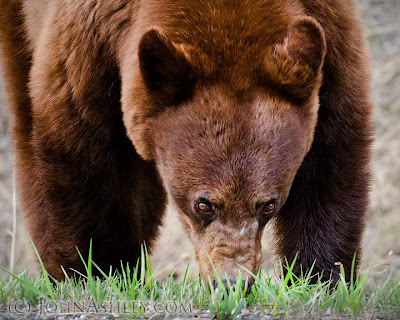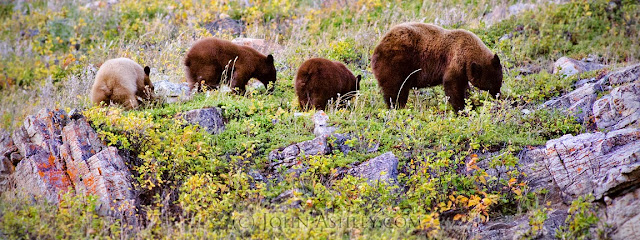 |
| Canine teeth visible on a young grizzly bear eating spring forbs and grass |
Canines are mostly useful for tearing into hide and pulling off chunks of meat, which any bear is happy to do on the few occasions that it catches an old or weak animal, or follows its nose to the recently deceased.
But meat is an infrequent menu item for grizzlies and a rare treat for black bears. They eat mostly plants, and bears have to eat LOTS of plant matter because they lack the herbivores' specialized digestive tract. Within this mostly vegetarian diet, the plant species eaten by Montana bears vary considerably between seasons and regions.
SPRING
Bears resume eating 1-2 weeks after emerging from their winter dens. Grizzlies head for the avalanche chutes to sniff out the frozen carcasses of goats and sheep. Yellow hedysarum roots (Hedysarum sulphurescens) are also sought out by grizzlies in the North Fork of the Flathead. But across the Continental Divide, whitebark pine nuts (Pinus albicaulis), sniffed out and dug up from squirrel caches, are important for the East Front grizzlies and those living down in Yellowstone. Yellowstone grizzlies will prey on wobbly elk calves and injured bison bulls during the rut. They'll also appropriate wolf-killed carrion any time of year, but it is especially valuable in spring.
The black bears' curved claws are excellent for climbing trees, but not very good for digging in snow or rocks. So black bears spend most of the spring seeking out succulent, spring vegetation, especially horsetail (Equisetum spp.) and dandelions (Taraxacum spp.). For the first few days after sprouting, young plants are relatively high in protein and low in indigestible cellulose. And plants at higher elevations grow faster with less cellulose than those at lower elevations. Both species of bears follow the spring green-up uphill, and move from south-facing to north-facing slopes as the season progresses, maximizing the protein content of their chosen food plants.
Bears lack the multi-chambered stomachs of ruminants, like elk, and the enlarged cecum of rodents, like beavers, that enable these herbivores to break down and digest plant cellulose. But when compared to other carnivores, bears have an elongated digestive tract that makes them more efficient as plant eaters.
SUMMER
 |
| Black bear eating summer grass |
Both species eat lots of summer grasses and sedges and clover (Trifolium spp.) in all areas occupied by bears. Cow parsnip (Heracleum lanatum) rises in importance for grizzlies in the Flathead, while Yellowstone grizzlies take advantage of cutthroat trout (Oncorhynchus clarkii) spawning in shallow waters of several streams.
Both bear species also add insects to their diets as the bugs become more numerous in summer. Ants, bees, yellowjackets, grubs and beetles become increasingly important additions to the reduced menu of late-emerging plants. Bears will even spend the energy to eat earthworms.
Later in summer, groups of grizzly bears gather on rocky mountain tops in Glacier, Yellowstone and the Missions to lick up masses of army cutworm moths (Euxoa auxiliaris) hiding underneath the rocks. Moths by the millions migrate to Montana's meadows and mountain tops from farmland states many miles to the east and south, where the larval caterpillars are serious agricultural pests. A hungry bear can eat 20,000 to 40,000 of these adult moths each day, downing a whopping 300,000 calories in just 30 days - which is about 25% of the total calories they need to survive for one year. (Excellent video here, shortened version here.)
Lower down, black bears are eating lots of ants and plants. For many black and grizzly bears, mid to late summer is when they finally stop loosing weight and start putting on fat. Berry season has finally arrived!
AUTUMN
A multitude of wild Montana fruits begins ripening in late summer and comes on strong in early fall. Currents, gooseberries, cranberries, bilberries, kinnikinnick, salmonberries and blackberries, among many others. But this is first and foremost a feast upon two berries, huckleberries in the west and buffaloberries in the east.
Huckleberries (Vaccinium spp.) grow in thick patches in the (west side) North and South Forks of the Flathead, where all of the local bears gather and gorge. As huckleberries begin to diminish, mountain ash berries (Sorbus sitchensis) rise in importance. The primary berry east of the divide is buffaloberry (Shepherdia canadensis), which begins ripening in mid-August. During peak season, bears living east of the divide can consume 50,000 to 200,000 buffaloberries each day.
In the Mission Mountains, grizzly bears have also learned to eat domestic apples and plums. Orchard owners must remove any remaining fruit by fall, else the bears will break off branches while climbing row after row of valuable trees. Down in Yellowstone, some grizzlies turn their attention to bull elk that become weakened or injured during the fall rut.
WINTER
Bears often forage 20 hours a day in fall, adding as much as 35% to their body weight in preparation for winter hibernation. Between October and April, bears rest in snow-covered dens while their main foods are scarce or absent. In addition to females giving birth and nursing while asleep, something else takes place during hibernation that's almost as amazing.
A hibernating bear burns almost as many calories as an active bear. A bear's body temperature only drops by 3-5F degrees, and its heart rate reduces by about 35%. It doesn't eat or drink (or defecate or urinate). A bear survives strictly by burning fat, not muscle. Bears are also able to recycle nitrogenous waste urea back into protein. The ability to survive for 5-7 months while burning roughly 4,000 calories each day during hibernation is truly an amazing feat. Perhaps we should feel more impressed by the marvels of hibernation and become less preoccupied with those big, canine teeth.
 |
| Black bear sow with three cubs feasting in a patch of low-growing kinnikinnick berries during fall |

